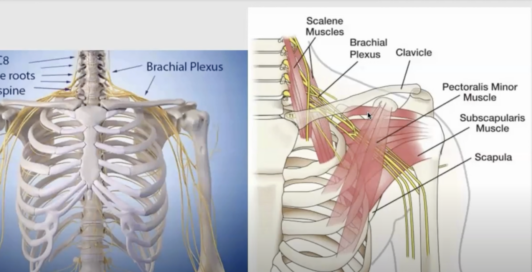Our May Feeling Fit Zoom group featured Arielle Levy, a physical therapist from Re+Active Physical Therapy founded by Julie Hershberg (a legend in the FSHD community). Following the introductory information below, you’ll find a downloadable list of her exercises and the video of the Zoom session.
We see a lot of postural impairments that come along with FSHD as well as with compensatory movement patterns. The muscle weakness patterns can lead to different stressors on the system: joint stiffness, nerve stiffness, disuse atrophy, and secondary effects from these. Some of the pain that people might experience might be spasm or numbness and tingling or muscle stiffness. This is a common upper extremity pattern that we see a lot because of muscle weakness that happens in the back, in the middle traps and the lower traps as well as some of the scapular muscles.
 The shoulder blades tend to wing (tip forward) and people might have a hard time getting movement of those shoulder blades, which is important for lifting the arms. When the shoulder blades tip forward, the muscles of the back become lengthened and stretched all the time. At the same time, you might get compression and shortening of some of the muscles in the front of the body and shoulder. We have a network of nerves that come out from the spine segments like a bunch of telephone wires throughout our body under muscles and bones. For the upper extremities, the nerves come out from the neck and run under the collar bone. The pectoralis minor goes right over some of those nerves that feed into the arm, so a lot of times when people are having wrist pain, numbness tingling in the fingers, or elbow pain, you want to look at different sites where these nerves can be compressed along the neck, shoulder, elbow, wrist—there are a lot of different areas that can contribute to that compression.
The shoulder blades tend to wing (tip forward) and people might have a hard time getting movement of those shoulder blades, which is important for lifting the arms. When the shoulder blades tip forward, the muscles of the back become lengthened and stretched all the time. At the same time, you might get compression and shortening of some of the muscles in the front of the body and shoulder. We have a network of nerves that come out from the spine segments like a bunch of telephone wires throughout our body under muscles and bones. For the upper extremities, the nerves come out from the neck and run under the collar bone. The pectoralis minor goes right over some of those nerves that feed into the arm, so a lot of times when people are having wrist pain, numbness tingling in the fingers, or elbow pain, you want to look at different sites where these nerves can be compressed along the neck, shoulder, elbow, wrist—there are a lot of different areas that can contribute to that compression.
If you have abdominal weakness, that might lead to a significant arch in the lower back, and if you’re in that position chronically, you are getting a lot of compression on areas of the lower back. You may compensate in the way that your hips are moving. You may getting excess movement and that puts a lot of stress on some of these nerves. There are a lot of different points where you can get compression as well as stretch or tension on nerves. These nerve communicate with the glutes, leg muscles, and foot muscles. If you are compensating in the way you are moving, or if you are sitting a lot, that compresses some of these nerves. The nerves tend to be really sensitive. They need blood flow and space, they like movement. So when they are not getting these things, it can result in pain, numbness, tingling, muscle spasms.
In this video, we will learn some upper- and lower-body movements that can give the nerves better blood flow, movement, and space.
Arielle Levy’s Nerve Mobility Exercise List (downloadable file)


Hi Arielle,
I am 68 y old and was diagnosed 5 y ago. I do 3 times resistance training with a personal trainer and 2 days with a PT. My hamstrings are so weak, that I walk with hiking sticks outside my house. Otherwise my trainers say I am strong. Can you help?
Thanks
Neela Chipalkatty
neelake@aim.com